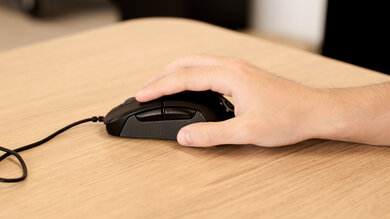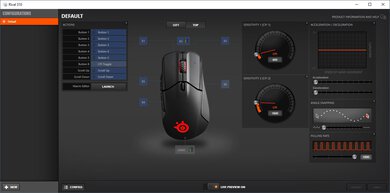The SteelSeries Rival 310 is a great wired gaming mouse. It looks and feels similar to the SteelSeries Rival 500, but with a less bulky design and less programmable side buttons. It's very comfortable to use with a palm grip for all hand sizes and has a low click latency. Its max CPI isn't quite as high as the Rival 500 but is likely more than sensitive enough for most people, and the mouse is fully compatible with both Windows and macOS, which is great.
Our Verdict
The SteelSeries Rival 310 is a good mouse for office use. Thanks to its right-handed ergonomic shape, it's very comfortable to use for extended periods, and the two programmable side buttons can help you navigate work software quicker. It's also fully compatible with both Windows and macOS, so you can use it on your work PC as well as your laptop, even if they use different operating systems.
- Fully compatible with both Windows and macOS.
- Very comfortable.
- Durable and well-built.
- No L/R tilt or horizontal scroll.
The SteelSeries Rival 310 is a great FPS gaming mouse. It's very comfortable to use for extended periods and its wired connection ensures low click latency. While its max CPI isn't as high as some other options, it's still likely more than sensitive enough for most people, and its CPI can be adjusted by increments of 100. Unfortunately, some FPS gamers may find it a bit heavy, and its rubber cable is somewhat rigid.
- Very comfortable.
- Low click latency.
- Durable and well-built.
- Max CPI isn't as high as some other options.
The SteelSeries Rival 310 is a very good mouse for MMO games, though it doesn't have nearly as many side buttons as dedicated MMO mice. It's comfortable enough for long gaming sessions and has low click latency. You can also install the SteelSeries software on both Windows and macOS, which is great if you like to play WoW on your MacBook.
- Very comfortable.
- Low click latency.
- Durable and well-built.
- Not as many side buttons as dedicated MMO mice.
- Max CPI isn't as high as some other options.
The SteelSeries Rival 310 is a fairly heavy mouse that isn't nearly as lightweight as dedicated ultra-light gaming mice. It's a good gaming mouse thanks to its low click latency and excellent sensor performance, but fans of very lightweight mice will likely want to look elsewhere.
- Very comfortable.
- Low click latency.
- Durable and well-built.
- Not nearly as light as dedicated ultra-light mice.
- Max CPI isn't as high as some other options.
The SteelSeries Rival 310 isn't recommended for travel. Like most wired gaming mice, it's quite bulky and won't fit into most laptop cases. It's also fairly heavy, and its wire is cumbersome when using in a tight space, like a plane.
- Fully compatible with both Windows and macOS.
- Durable and well-built.
- Bulky wired design.
Changelog
- Updated Oct 16, 2020: Converted to Test Bench 1.0.
- Updated Jun 19, 2020: Review published.
- Updated Jun 15, 2020: Early access published.
- Updated Jun 03, 2020: Our testers have started testing this product.
Check Price
Popular Mouse Comparisons
The SteelSeries Rival 310 is a great wired gaming mouse. It's similar to the SteelSeries Rival 500 but has fewer programmable buttons and a smaller and less bulky ergonomic design.
Check out our recommendations for the best gaming mouse, the best wired gaming mouse, and the best mouse overall.
The Razer DeathAdder V2 performs slightly better for gaming than the SteelSeries Rival 310. Both mice have about the same size and weight, but the Razer has better feet and more programmable inputs. It also has a wider CPI range that you can adjust more precisely, a lower lift-off distance, and a much better click latency. The SteelSeries has less CPI variation, and it’s fully compatible with both Windows and macOS. However, it’s not meant for a fingertip grip.
The SteelSeries Rival 310 is a predecessor of the SteelSeries Rival 5. The Rival 5 is a better gaming mouse overall as it's lighter, feels sturdier, and has more side buttons, including a toggle switch up/down inputs. It also has an updated sensor with a higher maximum CPI and a lower lift-off distance. It's ideal for all grip types but isn't suitable for smaller hands. On the other hand, the Rival 310 is better suited for small hands using a palm grip but is only recommended for a fingertip grip for extra-large hands.
The SteelSeries Rival 310 is a better wired gaming mouse than the Razer Basilisk. The SteelSeries is lighter-weight and slightly more comfortable thanks to its slanted, ergonomic shape. It's also fully compatible with both Windows and macOS, while the Razer is only partially compatible with Mac devices. However, while the click latency is slightly lower on the SteelSeries, the Razer has a wider adjustable CPI range, a lower lift-off distance, and more programmable buttons.
The SteelSeries Rival 310 and the Razer DeathAdder Elite are both great wired FPS gaming mice. The Razer has a wider CPI range that you can fine-tune by increments of 1, which is excellent. Also, it has a more consistent sensor and lower lift-off distance. On the other hand, the Rival 310 has a slightly lower click latency and is fully compatible with both Windows and macOS, while the Razer is only partially compatible with macOS.
Test Results

The SteelSeries Rival 310 has a straightforward design that looks very similar to the SteelSeries Rival 500, but with fewer buttons. It has textured rubber on each side and RGB lighting on the scroll wheel and rear logo. While our unit is all-black, this mouse is also available in PUBG or CS:GO color variants.
The SteelSeries Rival 310 gaming mouse is fairly heavy and has no weight optimization options.
The build quality of the SteelSeries Rival 310 is excellent. The entire mouse feels very sturdy with no loose or squeaking parts. It's made of good quality plastic, with a matte finish and rubber grips on either side. The PFTE feet are okay but aren't as good on some other mice, like the GLORIOUS Model O. Overall it feels as well-built and solid as the SteelSeries Rival 500.
The SteelSeries Rival 310 is very comfortable to use. It has a right-handed ergonomic slant that allows it to fit very well in the hand. Overall it feels like the SteelSeries Rival 500 but with less bulk.
This is a wired-only mouse.
The cable of this mouse is the same as the one found on the SteelSeries Rival 500, and is only mediocre overall. It's coated in rubber and maintains some kinks from the packaging.
This mouse has two additional side buttons, for a total of eight programmable buttons. While you can set a button to switch profiles, it will switch to a specific one so you'll need to set multiple buttons and can't simply scroll through your various profiles. For a similar gaming mouse with hot-swappable left and right-click switches, check out the ASUS ROG Chakram Core.
The mouse wheel is decent. Like with most SteelSeries mice, it's fairly low profile and doesn't stick out much. It's incremented with soft bumps, but unfortunately, there are no L/R tilt buttons.
The click latency of this mouse is quite low and most people likely won't notice any lag.
The software for this mouse is superb. It's fully compatible with both Windows and macOS and allows you to fully customize your mouse. The mouse also has on-board memory to save your settings between computers, though unfortunately, our settings didn't save when switching the mouse from Windows to macOS, and we had to reprogram the mouse on the Mac.












